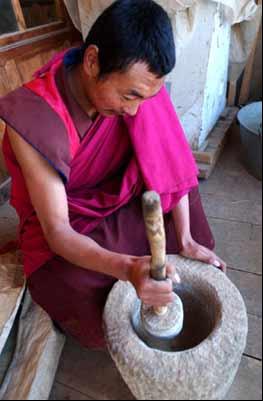Tibetan Medicine
Tibetan medicine is a centuries-old traditional medical system that employs a complex approach to  diagnosis, incorporating techniques such as pulse analysis and urinalysis, and utilizes behavior and dietary modification, medicines composed of natural materials (e.g., herbs and minerals) and physical therapies (e.g. Tibetan acupuncture, moxabustion, etc.) to treat illness.
diagnosis, incorporating techniques such as pulse analysis and urinalysis, and utilizes behavior and dietary modification, medicines composed of natural materials (e.g., herbs and minerals) and physical therapies (e.g. Tibetan acupuncture, moxabustion, etc.) to treat illness.
With the recent explosion of fascination with Tibet and Tibetan culture, Tibetan medicine is receiving greater attention from the public, scholars and the media. As with many aspects of Tibetan culture, significant and complex issues determine whether or not Tibetan medicine will continue to survive as a living tradition.
By synthesizing knowledge from various medical systems, Tibetans created a approach to medical science drawn from thousands of years of accumulated empirical knowledge and intuition about the nature of  health and illness. Centuries ago, before Buddhism entered Tibet, Tibetans like all ancient people had a significant degree of medical knowledge. According to traditional sources, in the beginning of the 4th century many new ideas regarding medicine began to enter the country. At first influences came from India in the form of what is now called Ayurvedic medicine, as well as more spiritual and psychologically based systems from Buddhist and other sources. Around the 7th-8th centuries the Tibetan government began sponsoring conferences where doctors skilled in the medical systems of China, Persia, India and Greece presented and debated their ideas regarding health and the treatment of illness. Those with superior abilities in the diagnosis, treatment and understanding of illness were invited to stay and contribute to the country's medical knowledge base. In the 11th century, this knowledge was codified into a unique system containing a synthesis of the principals of physical and psychological medicine imbued with a Buddhist spiritual understanding. This understanding formed a foundation for Tibetan medicine and benefited patients and doctors alike. It acknowledged how health and illness resulted both from the relationship between the mind and the body and people's connectedness to the natural world and sense of spirituality.
health and illness. Centuries ago, before Buddhism entered Tibet, Tibetans like all ancient people had a significant degree of medical knowledge. According to traditional sources, in the beginning of the 4th century many new ideas regarding medicine began to enter the country. At first influences came from India in the form of what is now called Ayurvedic medicine, as well as more spiritual and psychologically based systems from Buddhist and other sources. Around the 7th-8th centuries the Tibetan government began sponsoring conferences where doctors skilled in the medical systems of China, Persia, India and Greece presented and debated their ideas regarding health and the treatment of illness. Those with superior abilities in the diagnosis, treatment and understanding of illness were invited to stay and contribute to the country's medical knowledge base. In the 11th century, this knowledge was codified into a unique system containing a synthesis of the principals of physical and psychological medicine imbued with a Buddhist spiritual understanding. This understanding formed a foundation for Tibetan medicine and benefited patients and doctors alike. It acknowledged how health and illness resulted both from the relationship between the mind and the body and people's connectedness to the natural world and sense of spirituality.
Like other systems of traditional Asian medicine, and in contrast to biomedicine, Tibetan medicine first puts forth a specific definition of health in its theoretical texts. To have good health, Tibetan medical theory states that it is necessary to maintain balance in the body's three principles of function [often mistranslated as humors]: rLong (pron. Loong), mKhris-pa (pron. Tree-pa) [often mistranslated as bile], and Bad-kan (pron. Pay-gen) [often mistranslated as phlegm].
• Lung is the source of the body's ability to circulate physical substances (e.g. blood), energy (e.g. nervous system impulses), and the non-physical (e.g. thoughts). In embryological development, the mind's  expression of materialism is manifested as the system of rLong. There are five distinct subcategories of rLung each with specific locations and functions: Srog-'Dzin rLung, Gyen-rGyu rLung, Khyab-Byed rLung, Me-mNyam rLung, Thur-Sel rLung.
expression of materialism is manifested as the system of rLong. There are five distinct subcategories of rLung each with specific locations and functions: Srog-'Dzin rLung, Gyen-rGyu rLung, Khyab-Byed rLung, Me-mNyam rLung, Thur-Sel rLung.
• Mkhris-pa is characterized by the quantitative and qualitative characteristics of heat, and is the source of many functions such as thermoregulation, metabolism, liver function and discriminating intellect. In embryological development, the mind's expression of aggression is manifested as the system of mKhris-pa. There are five distinct subcategories of mKhris-pa each with specific locations and functions: 'Ju-Byed mKhris-pa, sGrub-Byed mKhris-pa, mDangs-sGyur mKhris-pa, mThong-Byed mKhris-pa, mDog-Sel mKhris-pa.
• Bad-kan is characterized by the quantitative and qualitative characteristics of cold, and is the source of many functions such as aspects of digestion, the maintenance of our physical structure, joint health and  mental stability. In embryological development, the mind's expression of ignorance is manifested as the system of Bad-kan. There are five distinct subcategories of Bad-kan each with specific locations and functions: rTen-Byed Bad-kan, Myag-byed Bad-kan, Myong-Byed Bad-kan, Tsim-Byed Bad-kan, 'Byor-Byed Bad-kan.
mental stability. In embryological development, the mind's expression of ignorance is manifested as the system of Bad-kan. There are five distinct subcategories of Bad-kan each with specific locations and functions: rTen-Byed Bad-kan, Myag-byed Bad-kan, Myong-Byed Bad-kan, Tsim-Byed Bad-kan, 'Byor-Byed Bad-kan.


